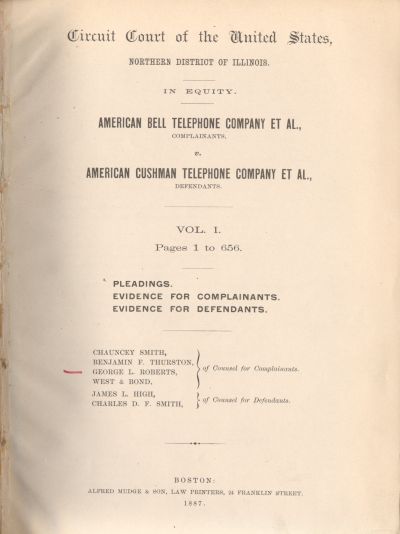 Chicago,
Monday, April 11, 1887, 10 A. M.
Chicago,
Monday, April 11, 1887, 10 A. M.
Who invented the telephone?
 Chicago,
Monday, April 11, 1887, 10 A. M.
Chicago,
Monday, April 11, 1887, 10 A. M.
Present: George L Roberts, Esq., Benjamin F. Thurston, Esq. and Chauncey Smith, Esq. for Complainants; Charles D. F. Smith, Esq. for Defendants
DEPOSITION OF SYLVANUS D. CUSHMAN.
Direct Examination by Charles D. F. Smith, Esq., of Counsel for Defendants.
Q. 1 What is your full name:
A. Sylvanus D. Cushman.
Q. 2. How old are you?
A. I was born the sixteenth day of February, 1819.
Q. 3. Where were you born?
A. Town of Orwell, county of Rutland, State of Vermont.
Q. 4. Have you ever been engaged in what is known as the telegraph business, in any of its departments?
A. Yes, sir, I engaged in the telegraph business in 1847 or 1848, and I have been engaged in that business more or less ever since.
Q. 5. Where were you residing in 1851?
A. I was residing at the city of Racine, State of Wisconsin.....
Q. 6. In what were you engaged during that year at Racine?
A. I was in the employ of the Erie and Michigan Telegraph Company....
... Q. 21. State what device, if any you had, connected with the apparatus already described, designed to determine the presence of atmospheric electricity upon the apparatus described, and how was it arranged, if any there was?
A. I had, in the further end of the box, an electro-magnet made in horseshoe form; in the centre of it a piece of steel; and over the top of that magnet a piece of sheet iron, so adjusted that when lightning struck the line, passing on to the first plate, discharging itself to the earth on to the second, passing on the same copper wire to the end of the box, then around the horseshoe electro, increasing the power of the electro-magnet sufficient to bring down this strip of sheet iron, it would be held to the top of the piece of steel, which was a permanent magnet, until some one pulled it off. I have forgotten to state that there was a small piece of what we call relay wire inserted in this circuit, so that when lightning struck the line, and the copper plates were not sufficient in number or size to take off the stroke from the cloud, I would find the small wire fused.
... Q. 30 Did you make more than one of this apparatus?
A. Yes, sir; there were two, both alike.
... Q. 32 Then if I understand you , one box was attached to the telegraph line, and located in the swamp under the bridge referred to, and the other box was located in the cellarway in question or referred to?
A. That is the way that I wish to be understood.
... Q. 34 What, if any, phenomena did you subsequently observe in connection with the boxes in question, or either of them?
A. While we were waiting for the thunder storm, with the boxes situated as I have described, a peculiar crackling noise towards evening was heard in the box in the cellarway; adjusting down the piece of sheet iron, with my hand I could once in a while receive a noise that myself and others who stood there believed to be the piping of frogs.
... Q. 36 On that occasion, or on any other occasion soon thereafter, did you hear any other noises proceeding from the box in the cellarway that attracted your attention in any way? If so, what noise did you thus hear?
A. During several days after I heard the first noise that I have mentioned, Mr. White and others frequently heard the same noise that I have tried to describe or have described. As soon as I got time I went out to the other end of the line, adjusted a piece of sheet iron over those magnets and found that by tapping the sheet iron with my pencil, Mr. White would answer me back, thus getting telegraph signals. Adjusting the instrument as well as we could during the next several days when I could, I could get Mr. White's voice; and, once in a while, a word very plain, but not loud. He said he could hear me when I hollered into the box or on to the sheet iron.
... Q. 48 When you say "we talked in the boxes, and listened at the hole in the boxes," do you mean to be understood that you could hear spoken words through the boxes; that is to say, words spoken into the funnel of one box could be heard at the opening of the other box, at the opposite end of the line?
A. Yes, sir; that is what I wish to be understood.
Q. 49 And what distance apart were the boxes at the time you thus used them?
A. From a half a mile to three. ........